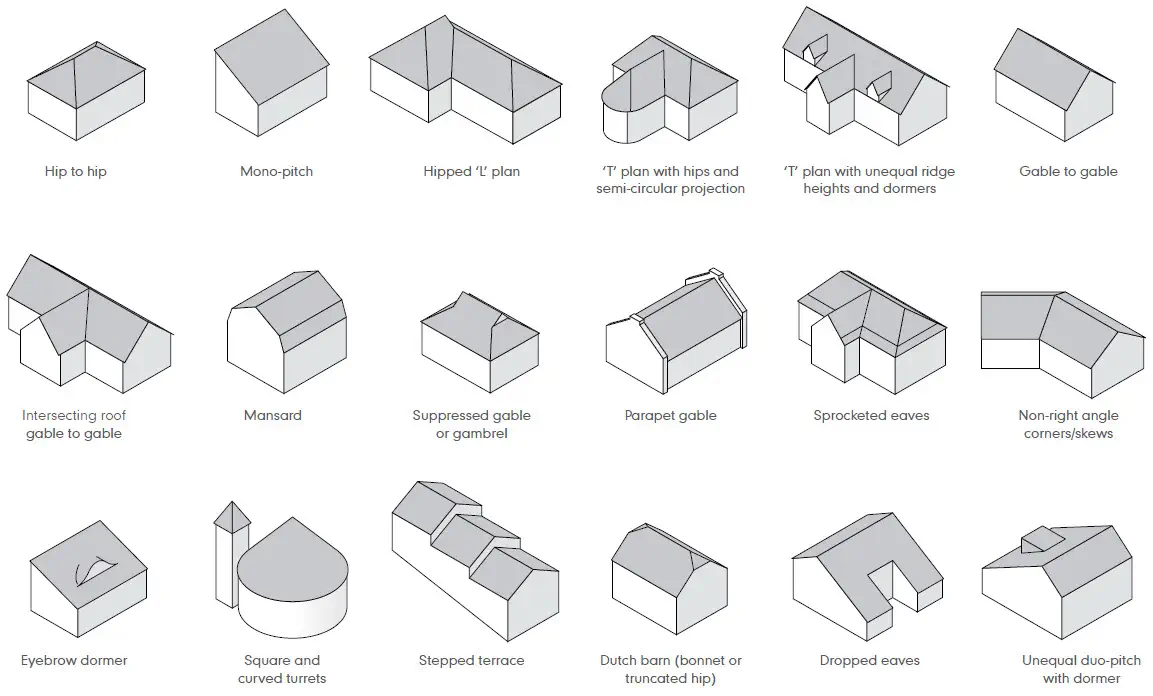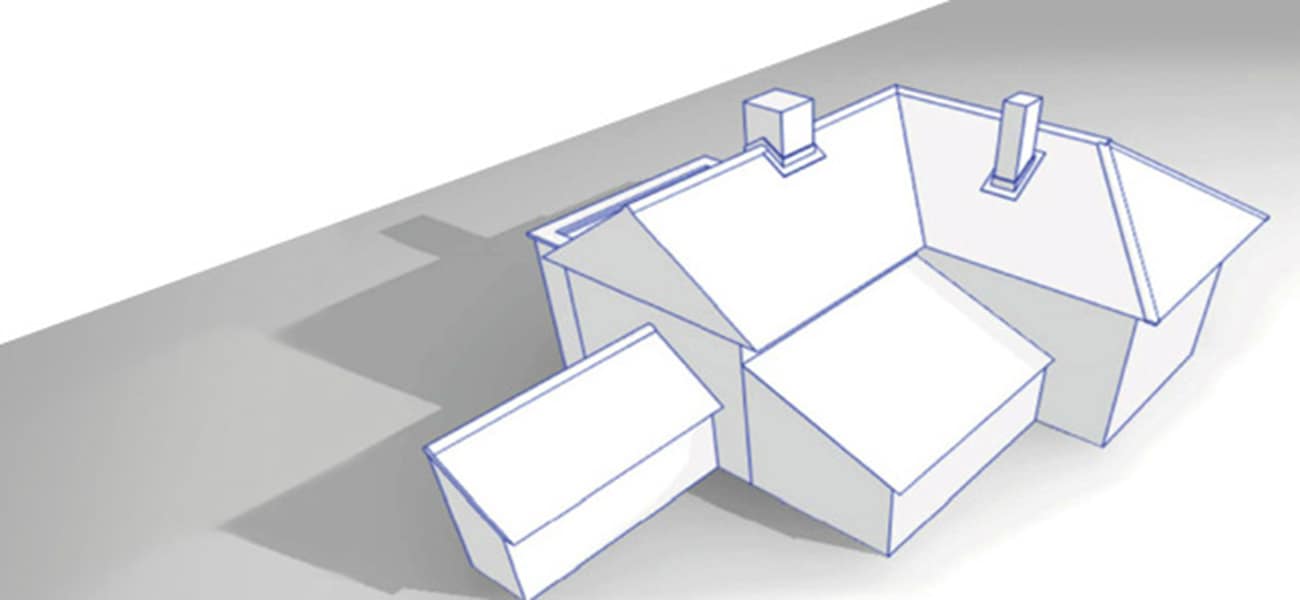Choosing a roof type: What are the different roof shapes in the UK
 Roofs are functional necessities, and they also play an important role in the character and aesthetic of a building. In the UK, there is a wide range of domestic roof types, with variations in shapes, roofing materials and appearances. Selecting the right roof type will depend on the architectural style of the structure, aesthetic preferences and the footprint of the building.
Roofs are functional necessities, and they also play an important role in the character and aesthetic of a building. In the UK, there is a wide range of domestic roof types, with variations in shapes, roofing materials and appearances. Selecting the right roof type will depend on the architectural style of the structure, aesthetic preferences and the footprint of the building. Let’s take a look at some of the different roof types, as well as how to choose the best roof type for a project.
Basic roof shapes
There are four main roof types used for housing. These are:
- Gable roof – Also known as a duo-pitch roof, this is the most common type of roof in the UK and is probably what most people think of when imagining a roof. A gable roof has two roof planes that extend downwards from the roof ridge to the eaves, resulting in the side ends of the house – known as the gable ends – having that classic pentagon house shape.
- Hipped roof: Another common choice for residential properties, a hip-to-hip roof features two sets of inclined roof sections that slope from the central ridge to the building's eaves. This creates a symmetrical profile when viewed from all four sides of the home. The roof hips are formed where adjacent roof planes meet.
- Mono-pitch: A mono-pitch roof has a single inclined plane that extends over the entire structure. This is a popular choice for modern architecture, as it provides a minimalist and asymmetric aesthetic.
- Flat or low-pitched roofs: Often used in extension projects, flat- and low-pitch roofs provide a minimalist appearance and can bend in well with their surroundings. Some flat roofs may also be used as roof terraces for extra outdoor space.
Roof types: common roof configurations
Depending on the shape of the house and architectural preferences, the four main roof types discussed above can be combined to create an array of roof configurations. Here are some of the more common roof shapes:
- Hipped 'L' plan – The hipped 'L' plan roof is used when a home's footprint is L-shaped. The roof follows the shape of the structure and has two ridges that may or may not intersect. This roof type is common in extensions to existing hip roofs.
- ‘T’ plan with hips and semi-circular projection – Used when a home's footprint is T-shaped, the roof follows the shape of the structure and has two ridges that may or may not intersect. For the semi-circular projection, the roof plane has a conical profile, adding visual interest to the roofline.
- Intersecting roof gable to gable – This roof shape involves two gabled roofs intersecting at right angles, providing distinct roof sections. The roof ridges often come together in a 'T' or 'L' shape.
- Non-right-angle corners/skews –These are similar to the 'L' or "T' plan roofs, but with angles other than 90 degrees. These roof types cater for unconventional house footprints and can be used to create dynamic and unique aesthetics.
- Unequal duo-pitch with dormer – This is a gable roof, but the roof planes are not equal in size or pitch. This creates an asymmetrical appearance and provides more variation in interior spaces. Dormers add habitable space in the loft area.
- 'T' plan with unequal ridge heights and dormers – This gabled roof design features different ridge heights for the intersecting sections. Dormers are used to turn the loft into a habitable area, providing additional space and light.
- Half-hip – Also sometimes known as a jerkinhead roof or a clipped gable, this is a hip roof, but two opposite planes are shorter than the other two. This creates two gable-like walls on the ends. Often, the larger roof planes have a slight curve for a flared appearance.
- Truncated hip roof – This is a hip roof with a flat top, rather than an angled ridge.
- Mansard – A mansard roof is a hip roof with a double-pitched design – that is, it has a flatter upper slope and a steeper lower slope. The transition between pitches can be sudden, for an angular appearance or curved for a more rounded look. Some mansard roofs have a truncated hip.
- Gambrel – Similar to a mansard roof, gambrel roofs also have a double-pitched design. The difference is that a gambrel roof has gables rather than hips.
- Suppressed gable – Also known as a gablet, this is a gabled roof combined with a hip roof. The gable end extends downwards for some distance and is then replaced with a hip roof.
- Dropped eaves – Also known as a catslide, this is a section of roof that extends beyond the rest of the roof, usually to cover a side room or extension. Sometimes they continue almost to the ground.
- Parapet gable – Also sometimes known as a Dutch gable, this roof type has a gable end that rises above the roofline. It often features a decorative finish or parapet, creating a distinctive architectural detail while concealing the roof edge.
- Sprocketed eaves – Also known as bellcast eaves, sprocketed eaves extend beyond the walls of the house and feature a concave curve that flattens out slightly at the edge. This is accomplished by laying the roof tiles at a different angle from those above. The result is a flared appearance that adds a traditional charm. This roof type can also help to keep rainwater flowing away from the walls of the home.
- Bonnet roof – Sometimes known as a Dutch barn, this is a hip roof where the eaves extend beyond the edge of the building at a shallower pitch to create an overhang.
- Eyebrow dormer – As opposed to standard dormers which feature straight lines, an eyebrow dormer is a small, curved dormer that projects from the slope of the roof. It resembles an eyebrow and offers a way to add light and space to the loft space.
- Stepped terrace – A stepped terrace roof features a series of flat roof sections at varying heights, resembling steps. These are often used to maximise space or views.
- Turrets –These small, tower-like structures extend from the wall of a building. They can be round or square and the roofs can be pyramids, conical or domed.
What’s the best roof covering for the different roof shapes
Typically in the UK, domestic homes have pitched roofs that are covered with roof tiles or slates. Roof tiles are suitable for a wide range of roof types and come in an array of materials, such as clay and concrete, as well as a choice of shapes and colours for versatility and flexibility of design.Whatever the shape and function of the space beneath, it’s the roof type and detailing that have the greatest influence on the appearance of the building as a whole, as well as the roof’s performance.
Specification considerations when choosing a roof type
The design of a pitched roof is dictated initially by the shape of the building, the span between the structural elements and how the space enclosed by the roof is expected to be used. After structure and function have been considered, the design of the roof may be modified by other considerations, such as weathering, performance and aesthetics.
- Weathering – The general climate, local microclimate and exposure, particularly to wind, should all be considered carefully when choosing a roof type. In areas prone to heavy rainfall or snow, the roof design is crucial for preventing leaks, ensuring proper drainage and preventing excessive snow loading. Other climate-related factors include the type and positioning of thermal insulation, ventilation and resistance to wind uplift and driving rain. It's also important to account for resistance to birds, vermin, insects and pollution.
- Performance and compliance – Structural integrity, fire resistance, acoustic and thermal performance, condensation prevention, impact resistance and durability must all be carefully considered to ensure the finished roof is suitable for purpose and meets Building Regulations and guidelines set by the National House Building Council (NHBC).
- Aesthetics – The shape of the roof, as well as the colour, materials and shape of the roof tiles should all complement the home and its surroundings. Local planning requirements may have special requirements and heritage properties will also require careful choices.
- Solar suitability – If the roof is to include solar panels, this could influence the choice of roof type, as well as its orientation.
Design a variety of roof types with Marley
As experts in roofing materials, Marley offers everything you need to create standard hip and gable roofs, as well as a wide range of other roof types and shapes.
Our complete Marley Roof System includes a wide range of compatible roofing products – from battens and underlays to clay and concrete roof tiles, ventilation systems and the Marley SolarTile – enabling you to design a variety of roof types and our technical team is on hand to assist with specification, calculations and any other queries you may have. Contact us today to discuss how our roof system can elevate your next building project.
Disclaimer - The information shared in this blog is correct at the time of publication. Guidance, standards, and best practices may change over time, so if you’d like further clarification or the latest updates, please get in touch with the Marley Technical Advisory Team, who will be happy to help.
